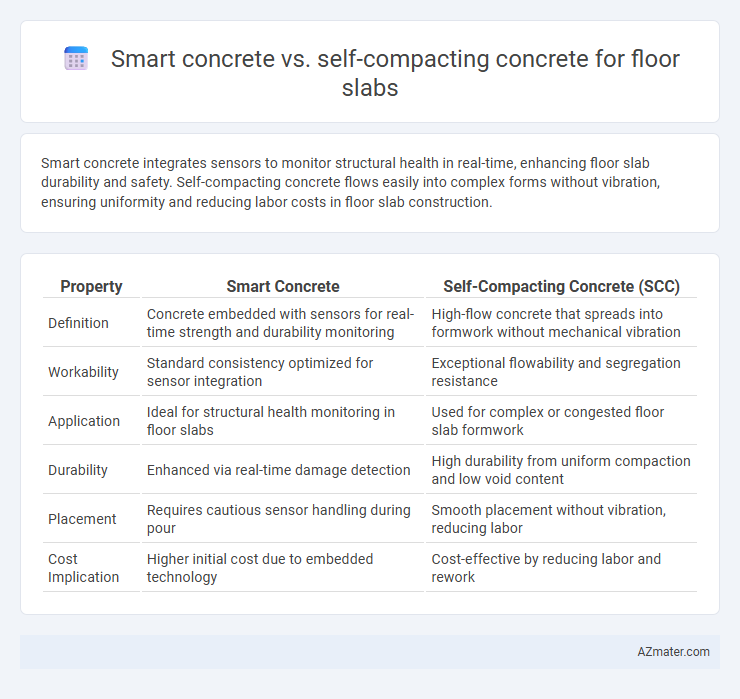Smart concrete integrates sensors to monitor structural health in real-time, enhancing floor slab durability and safety. Self-compacting concrete flows easily into complex forms without vibration, ensuring uniformity and reducing labor costs in floor slab construction.
Table of Comparison
| Property | Smart Concrete | Self-Compacting Concrete (SCC) |
|---|---|---|
| Definition | Concrete embedded with sensors for real-time strength and durability monitoring | High-flow concrete that spreads into formwork without mechanical vibration |
| Workability | Standard consistency optimized for sensor integration | Exceptional flowability and segregation resistance |
| Application | Ideal for structural health monitoring in floor slabs | Used for complex or congested floor slab formwork |
| Durability | Enhanced via real-time damage detection | High durability from uniform compaction and low void content |
| Placement | Requires cautious sensor handling during pour | Smooth placement without vibration, reducing labor |
| Cost Implication | Higher initial cost due to embedded technology | Cost-effective by reducing labor and rework |
Introduction to Smart Concrete and Self-Compacting Concrete
Smart concrete incorporates advanced materials and embedded sensors to monitor structural health and adapt to environmental changes, enhancing durability and maintenance efficiency in floor slabs. Self-compacting concrete (SCC) is designed for optimal flowability and compaction without mechanical vibration, improving surface finish and reducing labor in floor slab construction. The integration of smart technologies in concrete contrasts with SCC's focus on workability, each offering unique benefits for modern floor slab applications.
Key Properties of Smart Concrete for Floor Slabs
Smart concrete for floor slabs offers enhanced self-sensing capabilities through embedded nanomaterials, enabling real-time structural health monitoring and crack detection. Its superior durability and adaptability to environmental changes reduce maintenance costs and extend slab lifespan compared to traditional self-compacting concrete. The high electrical conductivity and strain sensitivity of smart concrete improve performance analysis and ensure proactive slab management.
Essential Features of Self-Compacting Concrete
Self-compacting concrete (SCC) is characterized by its high fluidity and ability to flow under its own weight, ensuring uniform filling of floor slab molds without the need for mechanical vibration. Its essential features include excellent workability, segregation resistance, and superior surface finish, which reduce labor costs and enhance durability. Compared to smart concrete, SCC offers enhanced placement efficiency and consistent quality critical for large-scale floor slab applications.
Comparative Strength and Durability Performance
Smart concrete incorporates embedded sensors and self-healing capabilities, enhancing real-time structural health monitoring and improving durability under stress conditions, whereas self-compacting concrete (SCC) emphasizes high flowability and uniformity, reducing voids and segregation for consistent compressive strength. In floor slabs, smart concrete typically exhibits superior long-term durability by actively repairing microcracks and limiting deterioration, while SCC provides excellent immediate strength and surface finish due to its fine particle dispersion and high workability. Comparative studies show smart concrete's adaptive properties contribute to extended service life, whereas SCC's homogeneous mix design ensures reliable strength performance during the construction phase.
Workability and Placement Techniques
Smart concrete utilizes embedded sensors and responsive materials that enhance workability by adapting to environmental conditions, ensuring optimal consistency during placement. Self-compacting concrete (SCC) exhibits superior flowability and can fill complex formworks and dense reinforcement without mechanical vibration, reducing labor and minimizing segregation risks. For floor slabs, the choice between smart concrete and SCC hinges on balancing adaptive workability with ease of placement, where SCC offers efficient, uniform filling and smart concrete provides real-time performance monitoring.
Cost Analysis: Smart Concrete vs Self-Compacting Concrete
Smart concrete offers enhanced durability and self-sensing capabilities that can reduce long-term maintenance costs despite its higher initial investment compared to self-compacting concrete. Self-compacting concrete provides faster placement and excellent flowability, lowering labor expenses and construction time, resulting in cost efficiency for standard floor slabs. When analyzing cost-effectiveness for floor slabs, the choice depends on project-specific requirements for structural health monitoring versus immediate construction savings.
Sustainability and Environmental Impact
Smart concrete incorporates sensors and adaptive materials that enhance structural health monitoring, reducing maintenance frequency and material waste, thereby promoting long-term sustainability for floor slabs. Self-compacting concrete minimizes the need for mechanical compaction, lowering energy consumption during construction and reducing emissions associated with labor-intensive processes. Both types contribute to environmental efficiency, but smart concrete's real-time data capabilities allow for optimized resource use and extended lifespan, supporting a circular economy in building materials.
Sensor Integration and Structural Health Monitoring
Smart concrete integrates embedded sensors such as fiber optic, piezoelectric, or wireless sensors directly into the floor slab matrix, enabling real-time data collection for structural health monitoring (SHM). Self-compacting concrete (SCC) offers superior flowability and uniformity, allowing for precise placement of sensors without compromising the slab's integrity or sensor functionality. The seamless integration of sensors in smart concrete combined with SCC's workability enhances durability assessment and early defect detection, optimizing maintenance strategies for floor slab infrastructure.
Case Studies: Real-World Floor Slab Applications
Smart concrete in floor slabs has demonstrated enhanced structural health monitoring through embedded sensors in case studies from infrastructure projects in Japan, enabling real-time crack detection and stress analysis. Self-compacting concrete (SCC) has been extensively utilized in floor slab applications in the UAE, where high flowability without mechanical vibration improved surface finish and reduced labor costs, as documented in large commercial building projects. Comparative studies from European construction sites highlight that smart concrete provides long-term durability monitoring, while SCC offers immediate benefits in construction speed and uniformity for floor slabs.
Conclusion: Choosing the Right Concrete for Floor Slabs
Smart concrete offers enhanced durability and real-time structural health monitoring, making it ideal for long-term infrastructure resilience in floor slabs. Self-compacting concrete ensures superior workability and uniformity in complex floor slab geometries, reducing labor costs and improving surface finish quality. Selecting between smart concrete and self-compacting concrete depends on project priorities such as monitoring needs versus construction efficiency and surface requirements.

Infographic: Smart concrete vs Self-compacting concrete for Floor slab
 azmater.com
azmater.com